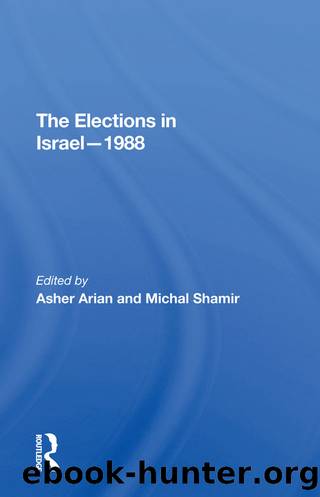The Elections in Israel--1988 by Asher Arian & Michal Shamir

Author:Asher Arian & Michal Shamir [Arian, Asher & Shamir, Michal]
Language: eng
Format: epub
Tags: Middle Eastern, Social Science, Political Science, World, Regional Studies
ISBN: 9781000316322
Google: 2u-aDwAAQBAJ
Goodreads: 50867819
Publisher: Routledge
Published: 1990-09-01T00:00:00+00:00
Notes
1.I wish to thank the Dartmouth College Committee on Research for its support of this project, and acknowledge the important contribution of my research assistants, Debbi Wilgoren and Rachael Winfree.
2. The main source of the 1984 and 1988 election statistics in this chart and elsewhere in this article was the tables prepared by the Minorities Department of the Labor Party (Tel Aviv: Israel Labor Party, 1988). For pre-1984 data I relied primarily on Raanan Cohen, Processes of Political Organization and Voting Patterns of Arabs in Israel (Hebrew), Part II, "Statistical Data," master's thesis (Tel Aviv: Tel Aviv University, 1985). Where obvious errors or lacunae exist in these sources I have utilized others, especially Henri Stellman, A Guide to the Israeli General Elections (London: The Anglo-Israel Association, 1988). Stellman's data were compiled from the Statistical Abstract of Israel Vol. 38 (Israel: Central Bureau of Statistics, 1987); Valdi Morag and Salman Aziza, "Results of the Elections to the Twelfth Knesset in the Arab Sector" (Hebrew) (Tel Aviv: Mapam Elections Bureau, 1988); Jacob M. Landau, "The Arab Vote," in Dan Caspi (ed.) The Roots of Îegin's Success (New York: St. Martin's Press, 1984) pp. 169-189; and Yosef Goell, "Minority Majority," The Jerusalem Post Magazine, August 10, 1984, Ï 6; and The Jerusalem Post, November 6, 1988.
3. On the importance of hamula rivalries in explaining support for Knesset lists in the 1984 election, see Joseph Ginat, "The Arab Vote: Protest or Palestinization?" in Asher Arian and Michal Shamir (eds.), The Elections in Israelâ1984 (New Brunswick: Transaction Books, 1986), pp. 152-53.
4. For a comprehensive analysis of this control system, see Ian Lustick, Arabs in the Jewish State: Israel's Control of a National Minority (Austin: University of Texas Press, 1980).
5. Sammy Smooha, The Orientation and Politicization of the Arab Minority in Israel, Occasional Papers on the Middle East, No. 2 (Haifa: Institute of Middle East Studies, University of Haifa, 1984); Sammy Smooha, "Are the Palestinian Citizens of Israel Radicalizing?" (New York: Conference of Association for Jewish Studies, CUNY, 1988).
6. These calculations are based on classifying Labor, Shinui, Yahad, CRM, Eliav, the PLP and Rakah as favoring territorial compromise; and the Likud, the National Religious Party, Tehiya, Shas, Morasha, Kach and Ometz as favoring permanent incorporation of the occupied areas. Votes for Agudah and Tami were excluded.
7. These figures are based on classifying the annexationist parties as Likud, Tehiya, Tzomet, Moledet and the National Religious Party. The anti-annexationist parties were Labor, Mapam, CRM, Shinui, and Meimad. The three ultra-orthodox parties were not classified, and votes cast for them are not reflected in these figures.
8. Sammy Smooha and Don Peretz, "The Arabs in Israel," Journal of Conflict Resolution, Vol. 26, no. 3 (September 1982), pp. 478 and 479.
9. Regarding Arab voters' antipathy to the Likud, and their desire to influence the election in 1981 by throwing their support from Rakah to the Alignment, see Ian S. Lustick, "Israel's Arab Minority in the Begin Era," in Robert O. Freedman (ed.), Israel in the Begin Era (New York: Praeger, 1982), pp.
Download
This site does not store any files on its server. We only index and link to content provided by other sites. Please contact the content providers to delete copyright contents if any and email us, we'll remove relevant links or contents immediately.
The Secret History by Donna Tartt(18860)
The Social Justice Warrior Handbook by Lisa De Pasquale(12143)
Thirteen Reasons Why by Jay Asher(8800)
This Is How You Lose Her by Junot Diaz(6802)
Weapons of Math Destruction by Cathy O'Neil(6152)
Zero to One by Peter Thiel(5692)
Beartown by Fredrik Backman(5609)
The Myth of the Strong Leader by Archie Brown(5429)
The Fire Next Time by James Baldwin(5252)
How Democracies Die by Steven Levitsky & Daniel Ziblatt(5133)
Promise Me, Dad by Joe Biden(5089)
Stone's Rules by Roger Stone(5028)
A Higher Loyalty: Truth, Lies, and Leadership by James Comey(4851)
100 Deadly Skills by Clint Emerson(4845)
Rise and Kill First by Ronen Bergman(4705)
Secrecy World by Jake Bernstein(4652)
The David Icke Guide to the Global Conspiracy (and how to end it) by David Icke(4629)
The Farm by Tom Rob Smith(4442)
The Doomsday Machine by Daniel Ellsberg(4420)
